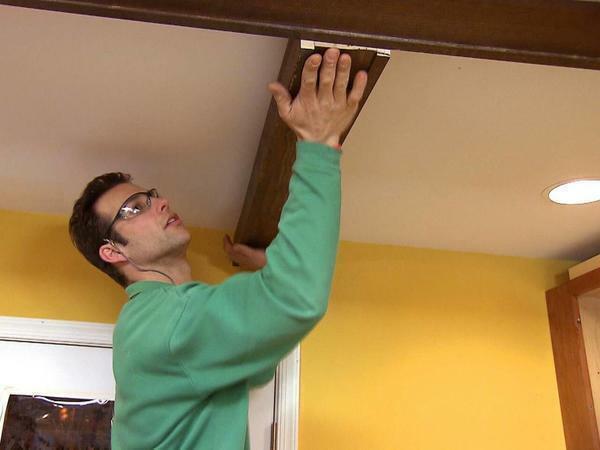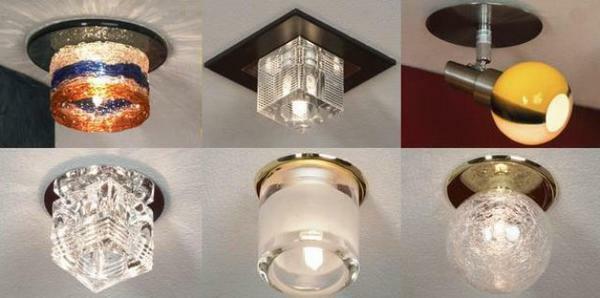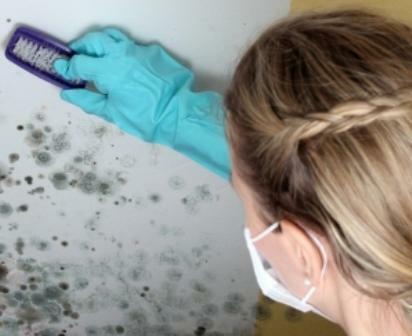 Dampness - a favorable environment for the growth of fungi Fungus on the ceiling in the bathroom is due to the fact that in this room there are positive conditions for the germination of this microorganism. It is not a plant, a bacterium, but a fungus. This means that its main part is the root that is hidden in a layer of concrete or trimmings. And it appears because of excessively high humidity, poor airing of the room or disruption of the finishing technology.
Dampness - a favorable environment for the growth of fungi Fungus on the ceiling in the bathroom is due to the fact that in this room there are positive conditions for the germination of this microorganism. It is not a plant, a bacterium, but a fungus. This means that its main part is the root that is hidden in a layer of concrete or trimmings. And it appears because of excessively high humidity, poor airing of the room or disruption of the finishing technology.
-
- Mold on the ceiling in the apartment
- Mold on the ceiling in the bathroom: how to deal with it
- Treatment of the fungus ceiling: how to produce
- Tips for treating the ceiling after a leak
- Than to treat the ceiling in a leakBathroom from mold: ways
- Fungus on the ceiling in the bathroom how to get rid of( video)
It's quite difficult to get rid of it. For example, if the capital ceiling is covered with a layer of ceramic tile, then even cleaning the fungus - it will reappear, and quite quickly. And all because of the root, which is removed mechanically - will not work( unless completely replacing the ceiling plate, but in multi-apartment buildings it is almost impossible).
Mold on the ceiling in the apartment
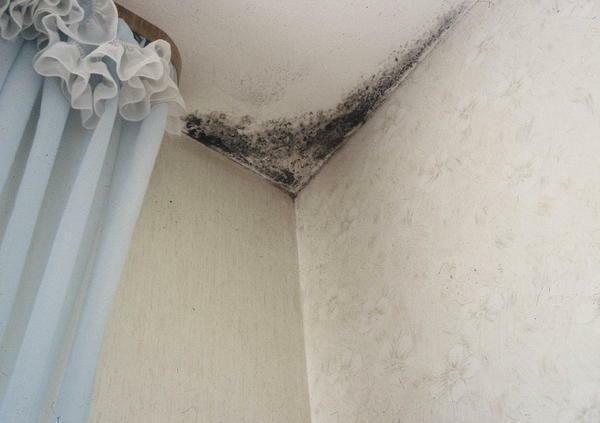 Mold is a spore-bearing mushroom. Spores settle on the lungs. The lungs become dirty - the appearance of diseases
Mold is a spore-bearing mushroom. Spores settle on the lungs. The lungs become dirty - the appearance of diseases
What will help the mold on the ceiling in the apartment?A very good effect is obtained by treatment with fungus with pesticidal agents. And after the root is eliminated, it is recommended to carry out additional treatment with a pesticide that penetrates deep into the wall. From above all this is primed, or covered with a special layer of plaster. If you do not do anything with the fungus, and immediately plastered the place of its spread, then very soon it will appear on top of this cladding.
The easiest way to fight a fungus is to prevent it.
For this, in each apartment during repair it is recommended:
- treat the ceiling with pesticides( it is better not to economize on them, since cheap ones are extremely toxic and unsafe);
- install compulsory ventilation, at least in the bathroom, or better - in the kitchen, on the balcony( will work on blowing);
- annually carefully study the entire lining for signs of fungus.
Mold on the ceiling in the bathroom: how to deal with it
Despite the prevailing opinion, the mold in the apartment has almost nothing to do with the fungus. Yes, they appear under the same conditions, but with mold it is easier to manage times. It is sufficient to treat it with a light chlorine solution and carefully wipe off the seams of the ceramic tile( if it is used).There is practically no "root" for it. There are not large sprouts, but they do not go deeper into the wall( however it is easy on plaster).
Still with mold offer to fight with copper sulfate, but this is a very harmful substance( if it is inhaled), but cheap. It is possible to apply, if temporarily nobody in the apartment plans to live. But such an "antifungal" treatment from all sorts of lichens will not help. The upper sphere of the "pest" will indeed be liquidated, but - temporarily.
Also with mold, you can fight with:
- solution of citric acid;
- whiteness;
- means for cleaning plumbing;
- hydrogen peroxide;
- vinegar essence( preferably at least 20 percent concentration);
- technical alcohol( denatured alcohol).
All these tools are very effective, they can be combined or processed several times, changing the active substance.
Treatment of the ceiling from the fungus: how to produce
To ensure that the ceiling is never covered with mold or fungus, it is necessary to carry out the treatment of the entire room with pesticides( not only the ceiling) during the construction or repair phase, regardless of which top will be the lining.
 As soon as the darkening in the corners of the walls is noticed, immediately start the treatment so that the mold does not spread over the entire room
As soon as the darkening in the corners of the walls is noticed, immediately start the treatment so that the mold does not spread over the entire room
Processing is still better to trust professionals, and if you do it yourself, it's necessary to observe the elementary rules of protection when working with poisonous substances.
What pesticides are popular for these types of work?For example, "The First Avenger".Quite cheap, but effective. It is recommended to treat the ceiling three times, with a period of 2-3 days. Above all, it is primed with emulsion paint( it can be plaster and even whitewash), and then the facing material is mounted, be it plasterboard, plastic or wood. By the way, they also need to be treated against fungi. Plastic - not necessary. Drywall - only if the manufacturer did not take care of it. Wood( binder) - if it is not varnished, not painted and not primed. By the way, for the latter, even a solution of PVA glue and distilled water will work. From above it will need to be varnished. By completing such a finish with quality ventilation - worry about the appearance of the fungus( even if it was before) is no longer needed.
Special attention should be given to:
- to the joints of concrete slabs( in panel houses);
- brick seams in the ceiling( on the walls).
If necessary, all these parts are opened, processed, and sealed with cement mortar again. Only in this way can the fungus be completely removed.
Tips for treating the ceiling after a leak
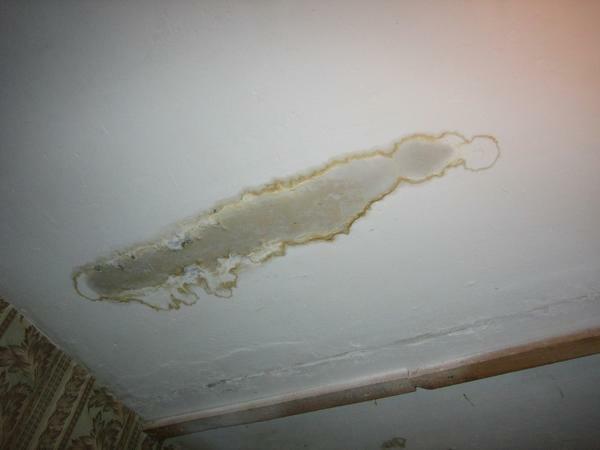 Before processing, weather the room, dry the walls. Only then begin the treatment of walls and ceiling
Before processing, weather the room, dry the walls. Only then begin the treatment of walls and ceiling
If the mold or fungus appeared after a leak from the neighbors from the top( or damaged roofing, if it is a private house), then the first thing to do is to dry the ceiling thoroughly. To close a concrete layer damp in any case it is impossible, as water can not evaporate and will lead only to growth of those most lichens.
How is shrinkage performed?Not only mechanically( exposure to heat at a high temperature), but also using chemical reagents that contact with water and absorb it( abstract).
Leakage may also occur due to mechanical damage to the riser. Naturally, in this case, you should immediately take up the repair of plumbing. And then - to deal with the processing of the ceiling. Then polyacrylate is used. This is a substance from which diapers are also created today. These are small crystals that are able to absorb a volume of water, which is 10 times the size of the same substance. And while polyacrylate is able to "draw" water from concrete. True, the process is not fast. And then the treatment of the ceiling is carried out in the same way as with simple removal of the fungus.
That is, when flooding or leaking it is necessary:
- completely drain the rough ceiling;
- replace the facing material;
- carry out treatment against the fungus of the ceiling and walls( recommended).
How to treat the ceiling in the bathroom from mold: methods
 Use disinfectants for disinfection of mold
Use disinfectants for disinfection of mold
Mold in the bathroom is very easy to handle. In principle, even a light soap solution will help. If you add acetic acid( concentration of about 20 percent) to it, then such a composition will also destroy the spores with which the mold reproduces. However, you need to be prepared, that such treatments will take several.
A more "aggressive" and at the same time effective option - treatment with ammonia, only after it there is a terrible stench in the apartment. But about the mold in the next 3-5 years just do not have to worry.
The ammonia can be replaced with meth( also called the technical essence of alcohol).Just to get it today is a problem.
You also need to mention a primer that has pesticides in its composition. With her, everything is generally simple - the ceiling is simply closed by whitewashing in several layers, for which you can engage in fastening finishing.
When removing mold, remember:
- it is necessary to eliminate the cause of its appearance( high humidity in sum with temperature over 24 degrees, poor ventilation);
- after removal - continue preventive treatment at least in the next 3 months;
- the lining is also treated against mold and fungus.
Fungus on the ceiling in the bathroom how to get rid( video)
And, by the way, mold is always a consequence of a malfunction of the repair technique or the failure of ventilation. If the ceiling has been processed in advance and there is forced ventilation in the house, even if the humidity reaches 80 percent, this will not lead to the formation of fungus or mold. And most often it begins to appear on the joints of panels or tiles. Therefore, the joints should be treated several times a year with alcohol or acetic solution.
